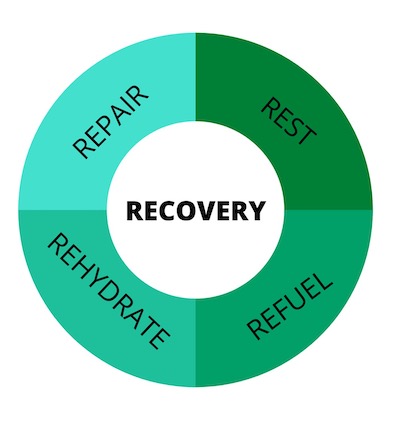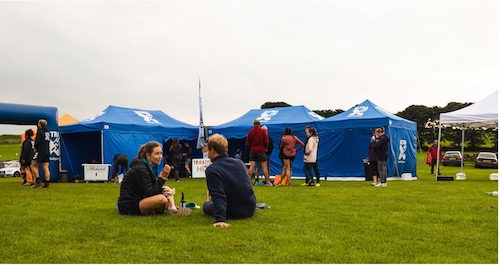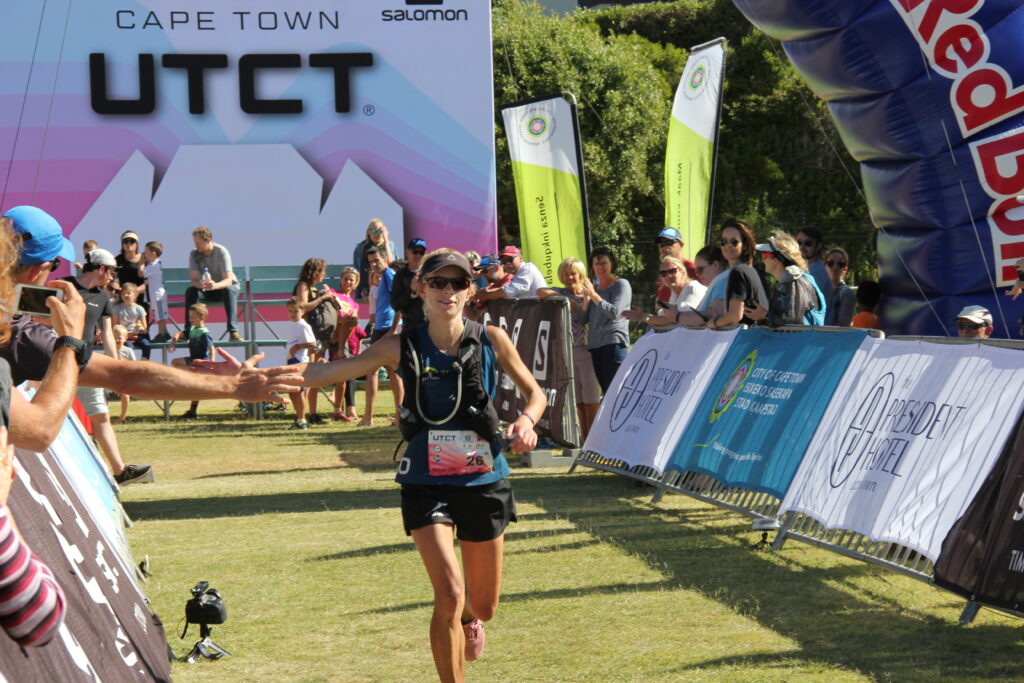As a sports dietitian I am often asked ‘what should I be eating on race day?’ and ‘what do you eat before you run?’. Whilst these are important questions I rarely get asked about the role of nutrition in recovery.
Recovery is a vital part of training and if you don’t give your body time to recover post training or competition then you may find that you are not able to complete the sessions you had planned. You may also find you are more prone to injury or feeling fatigued. Your recovery should be taken as seriously as your training.
The focus of a nutrition recovery strategy is to:
- Optimise muscle adaptation
- Help repair damaged tissues
- Restore muscle energy stores
- Replenish lost fluids
- Help prepare the body for further training/competition.
There are four main areas to focus on when discussing recovery:
- Refuel
- Repair
- Rehydrate
- Rest

Refuel
Refuelling is about replenishing your muscle glycogen stores using carbohydrate. Carbohydrate is needed to fuel almost all activity, and the amount of glycogen in your muscles and liver has an effect on your performance. When we exercise we use these stores; in the first hour of exercise most of our energy comes from muscle glycogen which will quickly deplete.
As you continue to run your body searches for other energy sources, and it utilises your blood sugar (glucose). This sounds great, but the supply is limited and when you start to reach the end of this supply you will ‘hit the wall’. This is why you need to take on some carbohydrate whilst exercising for longer periods.
The time that it takes to refuel is dependent on the intensity and duration of your session. The higher the intensity and the longer the session, you will need to allow more time to refuel. Some types of training can cause muscle fibre damage, especially seen in heavy-weight training, plyometric training or hard running. This can take up to 7-10 days to get back to full glycogen stores, as muscle damage delays this process. The higher your carbohydrate intake is, the faster you can refuel your glycogen stores.

Repair
Eating protein post exercise can help with improving training adaptations and enhance your performance. This is both in strength and endurance athletes. Particularly after resistance exercise, dietary protein is used to help rebuild any damaged muscle fibres. Over time this results in bigger and stronger muscles which is advantageous for both resistance and endurance performance.
Rehydrate
You need to ensure that you replace the fluid lost during exercise. The simplest way to work this out is to weigh yourself before and after training, as it is worked on the basis that 1l of sweat is equivalent to 1kg weight loss. So, you need to drink 1.2-1.5litres of fluids per kg body weight lost during exercise. This does not need to be all drunk straight away, drink however much you are comfortable with straight away then split the rest and continue until you are fully hydrated. Sports drinks that contain sodium (salt) and carbohydrate may help speed up your recovery; these can often be labelled hypotonic or isotonic. These can be particularly useful when you have a short period between sessions, and when fluid losses are especially high.

Rest
Although not strictly on the topic of nutrition, making sure you get a good night’s sleep and put your feet up is equally important. Aiming for 7-9 hours per night is optimal. Studies have found that increase in sleep duration and quality is associated with improved performance and competitive success. Studies have also found that sleep can reduce the risk of illness and injury. So, all in all, many reasons to go to bed early.

Timings
This is a hot and widely debated topic. Some feel that you must finish your training session and pick up a recovery drink straight away otherwise the session is wasted. However, this is not quite the case. The shorter the time between sessions, the more important the timing is. If you have back-to-back sessions within 24 hours then try to aim to have a recovery meal/snack within two hours. This should consist of carbohydrate and protein (in a 3:1 ratio). Recovery drinks are good to have, but if you have a balanced meal planned within a few hours of finishing then they may not be necessary. Generally aiming for ~1g carbohydrate per kg bodyweight + 20g protein is a good starting point.
Here are some examples:
- Sports recovery bar
- Chocolate milk
- Fresh yoghurt with fruit, honey or granola
- Smoothie (for example: 2 heaped spoons peanut butter, 1 banana, 100g fat free yoghurt)
- 2 slices wholemeal toast with nut butter
- Salmon/tuna/chicken/tofu with stir fried vegetables and rice
- Jacket potato with tuna
So now we know what to focus on, here are some of the top tips to help you achieve your optimal recovery:
- Start actively thinking about how nutrition fits into your recovery period after training or a race.
- If you have another training session within 24 hours or racing a multi-day event then ensure you really focus on achieving all the 4 R’s. As a general rule, the shorter the recovery time, the more important the timing and composition of post-exercise nutrition.
- Try to get at least 7 hours of sleep every night, try to establish a bedtime routine.
- Aim for 3:1 ratio (carbohydrate: protein) for the best-balanced recovery meal
- If you struggle to eat after training, then choosing a liquid recovery snack is a great alternative. However, you may find that leaving it a little longer post your session before you try eat may work well for you. Remember you don’t need to eat immediately after training.
- Practice: find what works for you, there is no one size fits all so you don’t have to eat or drink the same as everyone else, just because it works for them.
About the author: Rachel is a sports dietitian and ultra-runner. She supports athletes with their performance nutrition via Rachel White Nutrition.



